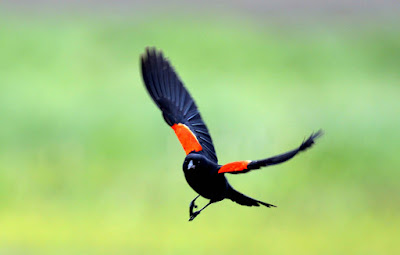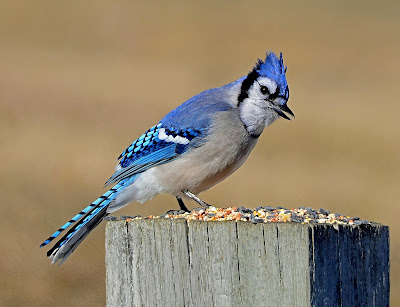Red-winged blackbirds are a sure sign of spring
I was down
in New York visiting family this past weekend and had a nice preview of what to
expect during the upcoming weeks of spring.
Spring! They are a little bit ahead of us down there-still no leaves on
the trees but there was green grass in the lawns and dandelions and daffodils
blooming. Robins were fighting over
territory in the park. My aunt was
bracing herself for her annual springtime battle with ants in her Manhattan
apartment. Like here I found mud,
peepers
and wood frogs calling at night, and one of my favorites, red-winged
blackbirds.
 |
| Male red-winged blackbird defending its territory USFWS Photo |
Red-winged
blackbirds arrived at my neighborhood marsh almost a month ago. Back before the last set of snow storms. They are there still but are a bit subdued, perhaps
because they’re still waiting for the ladies to arrive. This is in contrast to further south. Down in New York mating season is in full
swing, the males were busy perching in the cattails, on telephone wires and
stream-side shrubs, singing from any high place they could find while simultaneously
displaying those beautiful red-and-yellow shoulder patches that give this bird
its name.
Red-winged blackbirds are one of the most
abundant birds in North America and are probably the most well-known of the
blackbirds. The males are glossy black with those colorful shoulder
patches. They like to hang out up high
and display. The females have a subtle
beauty-brown and streaky-they look like a large, stream-lined sparrow. While
the males are displaying, the females are busy creeping through the undergrowth
collecting food (the majority of their diet is insects in the summer, seeds in
the winter) and building the nest. The
nests are works of art (as are most nests).
The female starts by weaving platforms of wet vegetation between reeds
or low shrubs upon which she builds up layers of wet leaves and decayed wood plastered
with mud to make a bowl that she lines with dry grasses (Cornell Lab of
Ornithology).
I have never knowingly seen a red-winged
blackbird nest but naturalist friends have warned me about trying to get too
close during breeding season. Both males
and females defend the nest with temerity and will not hesitate to dive bomb
and peck at your head. You will often
see red-winged blackbirds chasing potential threats much larger than themselves—hawks
and owls in particular-- they are notoriously bold in defense of their
territory.
Males arrive at the breeding site first to
establish territories that are instrumental in attracting females. Territories with dense vegetation so that
nests can be hidden from predators and abundant food are the best. Dominant males usually get the prime
territory. Once their territory is established,
males attract females with their mellifluous calls and flashy epaulets. The females chose males based on the
attributes of their territory, males with especially poor territories might end
up with no females, while males with choice territory often attract more than
one female. This is called polygyny, the
type of polygamy where males have many female mates. As many as 15 females have been found nesting
in the territory of one male! However,
many of these females also mate with males from outside their territory. Studies have found that often 25-50% of
nestlings in a given territory were not been sired by the territory-holder.
Red-winged
blackbirds are one of the most happy-sounding harbingers of spring. If you aren’t familiar with their liquid
song, go to a marsh right now and listen, if I can recognize it anyone
can. Ornithologist Frank Michler Chapman (1912) wrote this about how
great it is to hear those first red-winged blackbirds of spring "A swiftly moving, compact band of silent
birds, passing low through the brown orchard, suddenly wheels, and, alighting
among the bare branches, with precision of a trained choir breaks into a wild,
tinkling glee. It is quite possible that in the summer this rude chorus might
fail to attract enthusiasm, but in the spring it is as welcome and inspiring a
promise of the New Year as the peeping of frogs or the blooming of the first
wild flower."



Comments
Post a Comment